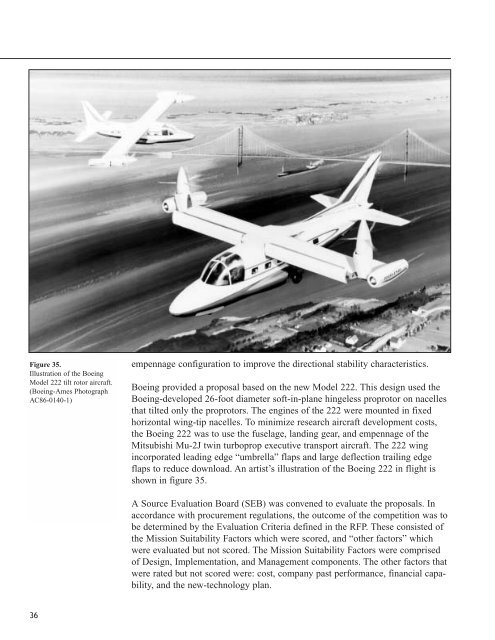XV-15 litho - NASA's History Office
XV-15 litho - NASA's History Office
XV-15 litho - NASA's History Office
Create successful ePaper yourself
Turn your PDF publications into a flip-book with our unique Google optimized e-Paper software.
Figure 35.<br />
Illustration of the Boeing<br />
Model 222 tilt rotor aircraft.<br />
(Boeing-Ames Photograph<br />
AC86-0140-1)<br />
36<br />
empennage configuration to improve the directional stability characteristics.<br />
Boeing provided a proposal based on the new Model 222. This design used the<br />
Boeing-developed 26-foot diameter soft-in-plane hingeless proprotor on nacelles<br />
that tilted only the proprotors. The engines of the 222 were mounted in fixed<br />
horizontal wing-tip nacelles. To minimize research aircraft development costs,<br />
the Boeing 222 was to use the fuselage, landing gear, and empennage of the<br />
Mitsubishi Mu-2J twin turboprop executive transport aircraft. The 222 wing<br />
incorporated leading edge “umbrella” flaps and large deflection trailing edge<br />
flaps to reduce download. An artist’s illustration of the Boeing 222 in flight is<br />
shown in figure 35.<br />
A Source Evaluation Board (SEB) was convened to evaluate the proposals. In<br />
accordance with procurement regulations, the outcome of the competition was to<br />
be determined by the Evaluation Criteria defined in the RFP. These consisted of<br />
the Mission Suitability Factors which were scored, and “other factors” which<br />
were evaluated but not scored. The Mission Suitability Factors were comprised<br />
of Design, Implementation, and Management components. The other factors that<br />
were rated but not scored were: cost, company past performance, financial capability,<br />
and the new-technology plan.

















